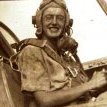

Hepster
Members-
Posts
424 -
Joined
-
Last visited
About Hepster
- Birthday 19/01/1958
Contact Methods
-
Website URL
http://
-
ICQ
0
Profile Information
-
Gender
Male
-
Location
Cheltenham, Glos
-
Interests
Anything military, but preferably British aircraft with roundels
Recent Profile Visitors
3,318 profile views
Hepster's Achievements

Established Member (3/9)
99
Reputation
-
As pointed out, the charge and projectile were not fixed. In addition to this, the higher charge settings were introduced after the muzzle brake was fitted later in WW2, otherwise the recoil would trash the mechanism. I cannot say where to draw the line on higher charges, so suggest that lower charges are shown in the model as the Tamiya kit has no muzzle brake.
-
I seem to recall attending a lecture by at SMW years ago in which Michael Ullman presented some evidence that the greenish tint arose from a late war mix of RLM76 which had a primer additive to allow it to be used on a surface without primer, thus saving both weight and time on an airframe which might not last long enough for the paint to get scratched anyhow.
-
MG17 (wings) MG81Z (rear cockpit)
-
'Panzers in Normandy - Then and Now' by After the Battle publications has a pic of a wrecked Panzer IVD in Normandy, but although it still has the short 75mm gin it has been refitted with the wider wheels and tracks that came in from the Panzer IVF onwards, so modelling would be tricky!
-
This has been covered often! Use the middle size nose for the NF12 in place of the overlong nose provided for the NF14. Also, remember that the band halfway along the main canopy is black; it is actually internal, though the kit shows it as raised external. The wheels are wrong, but you can't fix it, just go with it. Buy lots of filler.
-
I picked up both an Airfix T3 and Heller T3 at a show 5 years back, and the main difference was better plastic on the earlier Heller boxing, in that the Airfix boxing used a much softer plastic. This was a problem with the nosewheel, which is very thin and fragile. When I built the Airfix boxing, I resorted to coating the nosewheel in superglue in order to reinforce it. I recall having the same problem on a build of the Airfix FAW9, not surprisingly. The Airfix kits both had one piece 'wraparound' tail flashes, whilst the Heller boxing has the more common two piece. Decals were semi-translucent, so I used spares to double decal roundels because of poor colour density.
-
'Testing Colours' by Adrian Balch - Airlife 1993 - has a good air-to-air pic of WS838 as it banks away with a nice view of the underside of the port wing. There's also a pic taken air-to-air from above. The underwing serial is there, with no roundel, just like the flight-sim pic. The main differences are the fuel tanks - the photo shows the port tank and the belly tank in aluminium finish, whilst the starboard tank is yellow. All three tanks have the full set of stripe stencils. The upper wing roundels are small, the same size as the fuselage ones. There is a weird looking area just inboard of the upper port wing roundel that is painted black. There is no sloping whip aerial on the upper rear fuselage (incorrectly shown in the flight-sim pic), bit there is a white blade aerial.
-
I think that it is a Vulcan B.1. The first few delivered were painted overall aluminium finish, beginning with XA889 in 1956 and (probably) finishing with XA900 in 1957 since XA901 was the first to be delivered in overall anti-flash White. This narrows the above to 12 serials from XA889 to XA900 if my info is correct. As luck will have it, the two technicians working on the wing airbrakes are blocking the view of the serial, which is partly visible on the tail in black letters/numbers. The serial is also repeated on the lower part of the door under the nose, but I cannot read it.
-
The NF13 at Staverton (at the Jet Age Museum) is WM366 and has been restored at some time in the past with the nose from NF11/TT20 WM234, so that's why it does not have the intakes. It also has the tail from F8 VZ462, but hey.
-
I have a copy of this booklet in front of me - it lists the Kestrel as a future type 'when fully developed', a terrible artists rendition of the HS.801 maritime reconnaissance aircraft (what became the Nimrod} and the final page features the F-111 with the phrase 'Typical of tomorrow's RAF is the revolutionary F-111...' An enjoyable little booklet,, I shall use the Basset photo as a guide to doing the Basset in my stash...
-
The canopy could be jettisoned because, being hinged like it is, a belly landing that goes wrong and finishes upside down traps the pilot. Spits and Hurries can slide their canopies back to avoid this.
- 10 replies
-
- 1
-

-
- canopy
- artificial grass
-
(and 1 more)
Tagged with:
-
Nice one Kes, just enjoy the build! Coincidentally, I picked up a copy of the same kit at my local charity shop for all of £1.50. In view of the useful comments, I guess I'll just build it as a generic merchant ship of the period.
-

BOAC Boeing 707-436, Airfix 1:144
Hepster replied to neilg's topic in Ready for Inspection - Aircraft
What a beauty, I also built this fine kit last year, same issues with the engines. I also grafted in metal pin replacements for the probes o the wing and the tail, they were warped and flimsy on mine and needed sturdy replacements. -

109 rivets/options on airfix build. Help wanted/questions.
Hepster replied to Murewa's topic in Aircraft WWII
re 1 - the circular detail on the leading edge is a plated over gunport. The earlier 109s and the E-1 had a machine gun in this location, whilst the E-3 onwards had a 20mm cannon one frame further out, so that the inner gunport had to be covered. -

1915 HMS Dreadnought - 12" gun muzzle powder fouling
Hepster replied to micrometer's topic in Historic Vessels to 1914
It's not truly smokeless, more so the bigger the gun. As for staining, if a 20mm causes staining on a fighter plane, then a 12 inch on Dreadnought might be a bit worse.




